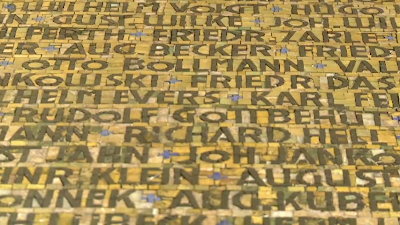
One of the most interesting sights on my Ruhrgebiet tour last week was Germans hurtling down the Autobahn with custom made flags attached to every part of their cars, despite the fact that Germany lost to Serbia. Gone are the days when Germans were required - as if by law - to suppress their nationalist enthusiasm. Though there was never a whisper of "Deutschland, Deutschland über alles" the boisterous cheering and flag waving had it playing a lot in my mind.

As I approached the square with the inspiring restored tower of 1879 beckoning me, a couple of homeless men sat on the steps and watched my every move. Determined to find the entrance to the church and then the information center where I would leave my name for inscription I walked from door to door. I peered through the glass doors of the tower to see the names of the Bochumers who lost their lives in World War I inscribed on the floor. These names will supposedly be joined by the living when the promise of the future in the form of this Platz des Europäischen Versprechens is handed back to the city of Bochum on December 31, 2010. I kept trying the doors, convinced I was at the wrong entrance. But no, there was no way in despite the fact that closing time was still an hour away.

Still hopeful, I found the office for the project, only to be disappointed – again - when there was no answer to the doorbell. An empty storefront on the Nordring has an information board on the project, it takes pride of place on Gerz website, and indeed, has its own website, so why could I not stir a sound from the doorbell, and all the doors were locked. Apparently, like so many of the Ruhr 2010 initiatives, of which this is one, the project has been stymied by lack of funds. The Platz des Europäischen Versprechens is temporarily “out of order” due to financial crisis.
Something about the desolation of this square, just behind the town hall at the very heart of Bochum, the doors all locked, the clochards on the steps, speaks the “promise” of Bochum’s present, and accurately reflects a “memorial” to an empty future. In a location where other European cities might be strained with the intensity of people, at its center Bochum is a shell, just like the Christuskirche itself was after World War II. As Florian and I were to discover over the following three days, inspite of the cutting edge ideas for artistic regeneration, the Ruhrgebiet is dead, shut down to culture and artistic innovation, pervaded by a sense of emptiness and the depressing air of a nevertheless one time thriving industrial mecca. No wonder there was so much excitement over the football: as the local paper announced the government plan to withdraw financing to the local Opel factory which is the main source of employment in the Bochum area, there is little else to celebrate in these parts.
No comments:
Post a Comment